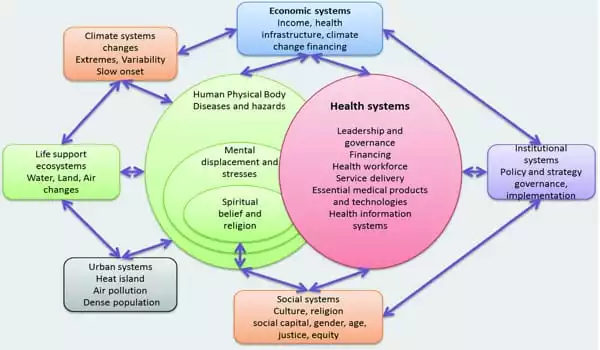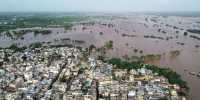It is concerned that human activities have significantly increased greenhouse gas concentrations in the atmosphere, that these increases amplify the natural greenhouse effect, and that this will result in an additional warming of the Earth’s surface and atmosphere, potentially harming natural ecosystems and humankind. Scientists propose a different approach to understanding and mitigating the health effects of human-caused climate and environmental change.
In a new study published in the journal One Earth, a team co-led by a Washington State University scientist proposes an alternative method for understanding and mitigating the health effects of human-caused changes to the climate and environment.
Deepti Singh, assistant professor in the School of the Environment at WSU Vancouver, drew on hundreds of studies of climate change, air quality, agriculture, and public health to propose a “systems lens,” or scientific approach, that connects health risks with concurrent environmental changes caused by human practices.
Scientists offer an alternative way to understand and minimize health impacts from human-caused changes to the climate and environment.
“The health consequences of air pollution, climate change, and agricultural transformations are frequently discussed separately,” Singh said. “However, these issues are all linked; they all stem from the same place, and each one has an impact on the others. Agricultural activities contribute to air pollution and influence regional climate patterns, while crop yield and quality are sensitive to air quality and climate conditions.”
Singh studied the situation in South Asia with researchers from Columbia University, the Indian School of Business, Boston University, and the University of Delaware, where rapid industrialization and modern farming practices have aided economic development and increased food production, but have also jeopardized multiple dimensions of human health.
“We’re providing a framework for assessing the overall health impacts of multiple parts of Earth’s natural systems that are all changing at the same time as a result of human activity,” Singh explained. “The research could aid in the identification of policies and solutions with multiple co-benefits for the environment and human health. Our research sheds new light on how food systems influence and are influenced by climate change and air pollution “Kyle Davis, co-author and assistant professor at the University of Delaware, shared his thoughts.

The scientists examined numerous examples of health impacts from changes in climate, air quality, and agricultural output, as well as co-benefits and unintended consequences of efforts to reduce emissions and save water. They discovered that these examples all share the need for improved tools and local, high-resolution data on health, weather, emissions, air pollution, and land use in order to better measure human and environmental impacts.
“This study highlights the problem with simplistic explanations and highlights how useful and effective policy responses must take multiple factors and interactions into account,” said Ashwini Chhatre, co-author and associate professor of public policy at the Indian School of Business.
The use of fossil fuels, the burning of crop residue, and changes to the landscape caused by agricultural expansion and intensification have contributed to extremely poor air quality in South Asia, altering the main source of rainfall, the summer monsoon, and increased health risks for nearly a quarter of the world’s population living in the region.
“Late autumn is ‘pollution season’ in north India, and also brings vicious debates in our society about who and what is contributing to it,” Chhatre said.
Furthermore, increased frequency and intensity of heatwaves and floods have killed thousands, displaced millions, reduced labor productivity, and caused disease outbreaks. Severe air pollution has been linked to an increase in heart and lung diseases, as well as millions of premature deaths and weakened monsoon rains. Simultaneously, air pollution and climate change have reduced the yields of critical food crops.
“While the climate benefits of today’s reductions in greenhouse gas emissions may not be felt for decades,” Singh said, “our approach sheds light on some of the immediate health benefits, as well as unintended consequences, of policies that aim to minimize human impacts on climate and the environment.”
The assessment of the health impact of global climate change presents a number of unique challenges. It is a globally dispersed exposure for which very little information (in the form of climate projections) is available at the local or national level. For many health effects, this is a long-term issue that will develop over decades or longer. Action is required immediately to avert the worst effects by reducing greenhouse gas emissions.















